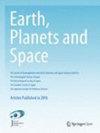A review of shallow slow earthquakes along the Nankai Trough
IF 2.5
3区 地球科学
引用次数: 0
Abstract
Abstract Slow earthquakes occur at deep and shallow plate boundaries along the Nankai Trough. Deep slow earthquakes are continuously distributed along the 30–40 km depth contours of the upper surface of the subducted Philippine Sea Plate. In contrast, shallow slow earthquakes occur in limited regions: Hyuga-nada, off Cape Muroto, and southeast off the Kii Peninsula. This review provides an overview of the up-to-date seismological, geodetic, geological, and experimental results in the shallow Nankai area for a unified understanding of the spot-like occurrence of shallow slow earthquakes. Shallow slow earthquakes tend to be distributed in transitional regions between the frictionally locked and stably sliding zones on the plate boundary. Based on geological and experimental studies, the lithology of incoming sediments and their friction coefficients can be variable along the Nankai Trough. Laboratory friction experiments revealed that sediments under shallow plate boundary conditions often exhibit positive ( a − b ) values, while negative ( a − b ) is possible via several processes. Subducted seamounts create complex fracture networks and stress shadows in their surrounding areas; however, not all subducted seamounts are related to shallow slow earthquake activities. This incomplete correlation suggests that alternative factors are required to explain the spot-like distribution of shallow slow earthquakes in the Nankai subduction zone. High pore fluid pressure conditions around shallow slow earthquake zones were interpreted based on seismological structural studies. In addition, ambient noise monitoring revealed temporal changes in seismic velocity structures associated with shallow slow earthquake migrations. This result suggests a close link between pore fluid migration and shallow slow earthquake episodes. Because transient changes in pore fluid pressure can lead to various slip behaviors, the episodic migration of pore fluid around the plate boundary could promote shallow slow earthquake activity along the Nankai Trough. Graphical Abstract南开海槽浅层慢震研究述评
慢震发生在南开海槽的深、浅板块边界。深慢地震沿菲律宾海板块上表面30 ~ 40 km深度等高线连续分布。相比之下,浅层缓慢地震发生在有限的地区:Hyuga-nada, Muroto角附近,Kii半岛东南部。本文综述了南开浅层地震、大地测量、地质和实验等方面的最新研究成果,以期对浅层慢震的点状发生有一个统一的认识。浅源慢震往往分布在板块边界摩擦锁定带和稳定滑动带之间的过渡区域。根据地质和实验研究,南开海槽入海沉积物的岩性及其摩擦系数可能发生变化。实验室摩擦实验表明,浅板边界条件下的沉积物通常呈现正(a−b)值,而负(a−b)可能通过几个过程。俯冲海山在其周围区域形成了复杂的裂缝网络和应力阴影;然而,并非所有的俯冲海山都与浅层缓慢地震活动有关。这种不完全的相关性表明,需要其他因素来解释南开俯冲带浅层慢震的点状分布。在地震构造研究的基础上,解释了浅层慢震带周围的高孔隙流体压力条件。此外,环境噪声监测揭示了与浅层缓慢地震迁移相关的地震速度结构的时间变化。这一结果表明,孔隙流体运移与浅层慢震事件有着密切的联系。由于孔隙流体压力的瞬态变化可导致各种滑动行为,孔隙流体在板块边界附近的幕式迁移可能促进南开海槽浅层缓慢地震活动。图形抽象
本文章由计算机程序翻译,如有差异,请以英文原文为准。
求助全文
约1分钟内获得全文
求助全文
来源期刊

Earth, Planets and Space
地学天文-地球科学综合
CiteScore
5.80
自引率
16.70%
发文量
167
期刊介绍:
Earth, Planets and Space (EPS) covers scientific articles in Earth and Planetary Sciences, particularly geomagnetism, aeronomy, space science, seismology, volcanology, geodesy, and planetary science. EPS also welcomes articles in new and interdisciplinary subjects, including instrumentations. Only new and original contents will be accepted for publication.
 求助内容:
求助内容: 应助结果提醒方式:
应助结果提醒方式:


